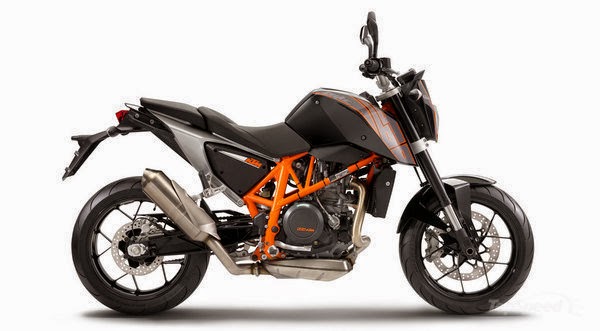SPECIFICATIONS:
year: 2014
make: KTM
Model: Duke
Engine: Single-cylinder, 4-stroke, spark-ignition engine, liquid-cooled
Transmission: 6-speed
Horsepower @ RPM: 37
Energy: Fuel injection
Displacement: 690 cc
Meet the 2014 KTM 690 Duke, a fast bike aimed at adrenaline-hungry riders. While designing the 690 Duke, KTM’s engineers have focused on cutting the bike’s weight as much as possible. Therefore, the motorcycle comes with a 9 kg lightweight tubular space frame made from chrome-molybdenum steel which is paired with a 4 kg lightweight, pin-jointed, die-cast swingarm. After this entire struggle the engineers have managed to obtain a dry weight of only 149.5 kg (without fuel), which is pretty impressive.
At the heart of the motorcycle lies a modern, 690 cc, single-cylinder, 4-stroke, spark-ignition, liquid-cooled engine. The unit develops a maximum power of 67 hp and is mated on a six speed, claw shifted transmission.
As far as suspensions are concerned, the KTM 690 Duke is equipped with front WP Suspension up side down forks and a rear WP Suspension shock absorber with Pro-Lever linkage.
Overview
The Essence of Motorcycling
Back then, KTM revived the pure, unadulterated single-cylinder motorcycle in the form of the "original" Duke. Judging by the latest 690 Duke that stands before us today, much has been gained: smoothness, room for a pillion passenger, long-distance ability. But what it has never lost is its intensive and elemental ride dynamics. The most cutting-edge series production single-cylinder of our times and a precision chassis with a wealth of outstanding components turn every trip on the 690 Duke into an incomparable and unforgettable riding experience.
2014 KTM 690 Duke Features And Benefits:
Polished Ride Dynamics
Centralisation of masses
The Duke not only impresses with low weight and perfect chassis geometry; the centralisation of masses - for example, by positioning the brushed stainless steel pre-silencer under the engine - also contributes to its playful handling and razor-sharp precision.
ABS
The disengageable dual-circuit ABS system with 9M+ modulator tuned in cooperation with Bosch offers total protection against over-braking, while maintaining the full effect and perfect feedback of a genuine sports brake thanks to very fine sensors. Weighing no more than one kilogramme, the ABS system therefore allows extremely sporty braking. And prevents nose-overs actively and effectively.
Dynamic Cornering Fun
Frame and swingarm
Lightweight components in a large, lightweight entirety: The 9 kg lightweight tubular space frame made from chrome-molybdenum steel and the 4 kg lightweight, high-quality, pin-jointed, die-cast swingarm impress with extreme levels of torsional stiffness, providing the less than 150 kg 690 Duke with excellent tracking stability.
Suspension components
Well-equipped for every situation: The WP upside-down fork on the Duke with a 43 mm upright tube diameter and the pivot-arm articulated WP pressurised-gas monoshock excel with perfect tuning and an unbelievably broad spectrum of use for all demands, from relaxed cruising to racing around closed circuits.
New rims in the KTM design
New rims may not appear to be such an innovation at first sight nowadays. What new rims mean for a manufacturer perhaps becomes rather clearer measured against the present-day degree of perfection of practically all the parts of a motorbike: But major improvements don’t just take a couple of minutes these days. KTM has nevertheless allowed the best technicians to play around with very clever computation software until an extremely lightweight, aesthetically elegant but still very stable and durable set of rims emerged from the casting die.


